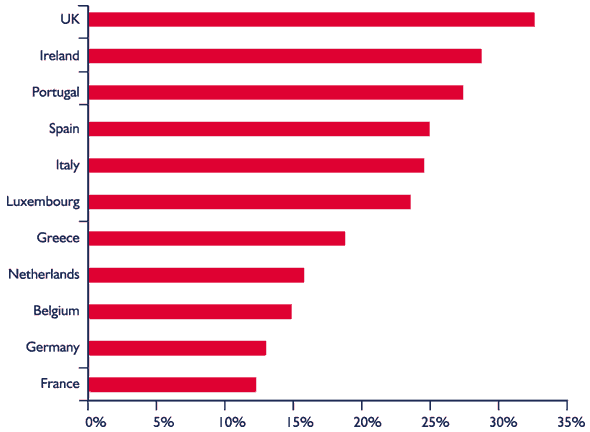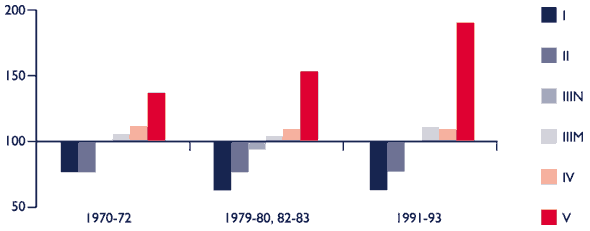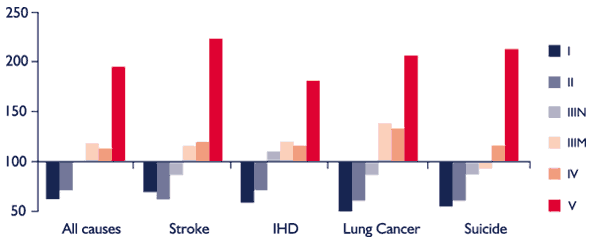 |
Close
window to return
|
Issue 4, July 1999, pp.2-3.
Introducing Phase
2 of the Programme
Hilary Graham
Background to the
Programme
The Health Variations Programme is designed to enhance the science-base
of public health policy. It is a field of policy which - at both international
and national level - is increasingly concerned with understanding and
tackling socio-economic inequalities in health.
In the international arena, the Declaration of the 1998 World Health Assembly
identified the reduction of socio-economic inequalities in health as a
priority for all countries. In Europe, the EU Action Programme on Public
Health is giving priority to improving the health of disadvantaged groups.
At the same time, the World Health Organisation (WHO) has launched a new
health strategy for Europe, Health 21. Improving health and promoting
equity are again the organising principles around which the WHO health
strategy is built. Underlying this two-track strategy is the recognition
that health inequalities are a barrier to wider gains in public health.
In other words, improved health turns on greater equity in health.
This twin-track strategy lies at the heart of the UK's new public health
agenda. Policies in England, Scotland, Wales and Northern Ireland share
a common commitment to improving population health and reducing health
inequalities. These policies have been launched against a backdrop of
widening class differences in wealth and health.
Trends in wealth
Over the last two decades, increased national prosperity has been achieved
at the cost of widening inequalities in living standards and increasing
poverty. Incomes in the top income decile grew by at least five times
as much as those in the bottom decile and the proportion of children living
below the EC poverty line increased from 1 in 10 to 1 in 3.(1) As Figure
1 indicates, the UK levels of childhood poverty are well above those elsewhere
in Europe. Poverty is also regionally and locally concentrated and the
evidence points to a widening gap between poorer and better off areas.
While there are areas with high levels of disadvantage (led by major cities
like Liverpool, Manchester and Birmingham and by Inner London boroughs
like Newham, Hackney and Tower Hamlets), most poor people do not live
in disadvantaged areas.(2,3)
Figure 1: Children in poor households (less than half average income)

Source: H.M. Treasury, 1999 (1)
Trends in health
Over the last two decades, increased life expectancy has been achieved
at a cost of widening health inequalities. Focusing on premature mortality,
Figure 2 captures this trend among men. Underlying the widening differentials
in all-cause mortality are widening differentials in major causes of premature
death, including coronary heart disease, stroke, lung cancer and suicide
(see Figure 3 for the current picture). Among women, widening health inequalities
have been fuelled by a steepening of the class gradient in deaths from
lung cancer and coronary heart disease and a flattening of the positive
class gradient in breast cancer mortality.(4) Among children, falling
mortality rates have again been associated with widening inequalities
in major causes of mortality, including accidents.(5)
Figure 2: SMRs by social class (based on occupation) males, England
and Wales 1970-72, 1979-80,
1982-1983 and 1991-1993. All causes

Source: Drever, Whitehead and Roden 1996 (16)
As the government recognises, reducing inequalities in these causes of
death requires a broad and radical vision of public health policy. It
is one which targets not only individuals and their risk behaviours. It
is also one which tackles the inequalities in life chances and living
standards which shape people's health and behaviour and improves the local
environment in which they live. As the new public health strategy for
England puts it, 'tackling inequalities generally is the best way of tackling
health inequalities in particular.'(6)
Tackling inequalities generally and tackling health inequalities in particular
requires an understanding of the links between them. Effective policies
require analyses which track how individual and area disadvantage shape
access to resources and exposure to risks - material, psycho-social and
behavioural - from before birth and across the lifecourse.
Figure 3: SMRs
from selected causes, by social class (based on occupation), men aged
20-64, England and Wales 1991-93

Source: Drever, Whitehead and Roden 1996 (16)
The Health Variations
Programme
The Health Variations Programme was established in 1996 to improve understanding
of the links between socio-economic status and health. Thirteen projects
were included in the first phase of the Programme. Among the issues addressed
by these projects are the lifecourse influences on health: how an individual's
socio-economic and health status are influenced by exposure to disadvantage
earlier in life.(7-9) Area influences have been another key theme, with
evidence suggesting that the area in which we live exerts an influence
on our health, over and above the effects of our individual socio-economic
circumstances.(10-13) The way in which ethnicity intersects with socio-economic
status has also been examined, with findings indicating that socio-economic
inequalities between and within ethnic groups make a major contribution
to ethnic differences in health.(14,15) Details of research in these areas,
as represented by published work, listed in separately, and are currently
available on the Programme website at: http://www.lancs.ac.uk/users/ apsocsci/hvp.htm.
Alongside these projects, a User Fellowship scheme has also been set up,
to help build bridges between the research and policy communities (see
article by Helen Roberts, Health Variations Programme Newsletter, Issue
4, pp.6-7).
The second and final phase of the Programme has now been launched. Like the projects in phase 1, the new projects focus on issues and questions likely to contribute both to the science of health inequalities and to the development of policies to reduce them. Among the questions the new projects address are:
- mental health: how do people's socio-economic circumstances, past and present, affect their mental health? can the mental health of poor communities be improved by urban re-generation programmes?
- psycho-social influences: what contribution do psycho-social factors, like job insecurity, stress and social support, make to the gradient in physical and mental health?
- lifestyle influences: what light do health-related behaviours, like diet and dieting, shed on the socio-economic gradient in health?
- life course influences: how does the toll which poor conditions take on health accumulate through childhood, across adulthood and into old age? what can we learn from the experience of earlier generations, as well as from children today?
- policy development and evaluation: are there inequities in health service utilisation at general practitioner level? what factors influence the development of local policies to tackle health inequalities? how can public understanding of equity inform health policy?
Three of these questions are the focus of articles in Issue 4: Stephen
Stansfeld on psycho-social influences, (Health Variations Programme Newsletter,
Issue 4, pp.4-5); Amanda Sacker on mental health (Health Variations Programme
Newsletter, Issue 4, pp.8-10), and Margaret Whitehead on policy impact
(Health Variations Programme Newsletter, Issue 4, pp.12-14). Together,
projects in the first and second phases of the Programme aim both to advance
the science of health inequalities and resource the development of policies
to take forward the UK's new public health agenda.
Hilary Graham is Director of the ESRC Health Variations Programme, based at Lancaster University.
References:
1. H.M. Treasury (1999) The Modernisation of Britain's Tax and Benefit
System, No 4, 'Tackling Poverty and Exclusion' London : H.M. Treasury.
2. Centre for Analysis of Social Exclusion (1999) Persistent Poverty
and Lifetime Inequality: the Evidence, Occasional Paper No.10, London
: H.M. Treasury/CASE.
3. Smith, G. (1999) Area-based Initiatives, CASE paper 25, London
: Centre for Analysis of Social Exclusion, London School of Economics.
4. Harding, S. et al (1997) 'Mortality trends using the Longitudinal Study'
in F. Drever and M. Whitehead, (eds.) Health Inequalities series
DS No.15 London : The Stationery Office.
5. Roberts, I. and Power, C. (1996) 'Does the decline in child injury
mortality vary by social class? A comparison of class specific mortality
in 1981 and 1991' British Medical Journal, 313 pp.784-6.
6. Secretary of State for Health (1998) Our Healthier Nation, London
: The Stationery Office.
7. Power, C. (1998) 'Lifecourse influences' Health Variations newsletter,
Issue 1 pp.14-15.
8. Benzeval, M. and Judge, K. (1998) 'Poverty and health', Health Variations
newsletter, Issue 1 pp.12-15.
9. Holland, P. et al (1998) 'The lifegrid method in health inequalities
research', Health Variations newsletter, Issue 2 pp.8-9.
10. Macintyre, S. (1998) 'Area influences in health', Health Variations
newsletter, Issue 1 pp.6-7.
11. Mitchell, R. et al (1998) 'Health: who you are or where you live',
Health Variations newsletter, Issue 2 pp.4-5.
12. Gatrell, T. (1998) 'Area inequalities in health', Health Variations
newsletter, Issue 2 pp.6- 7.
13. Shaw, M. (1998) 'Explaining geographical inequalities in health',
Health Variations newsletter, Issue 2 pp.8-9.
14. Nazroo, J. (1998) 'Ethnicity', Health Variations newsletter,
Issue 1 pp.10-11.
15. Charsley, K. et al (1998) 'Housing tenure, ethnicity and inequalities:
towards a contextualised approach' Health Variations newsletter,
Issue 3 pp.6-7.
16. Drever, F., Whitehead, M. and Roden, M. (1996) 'Current patterns and
trends in male mortality by social class (based on occupation)' Population
Trends, 86 pp.15-20.